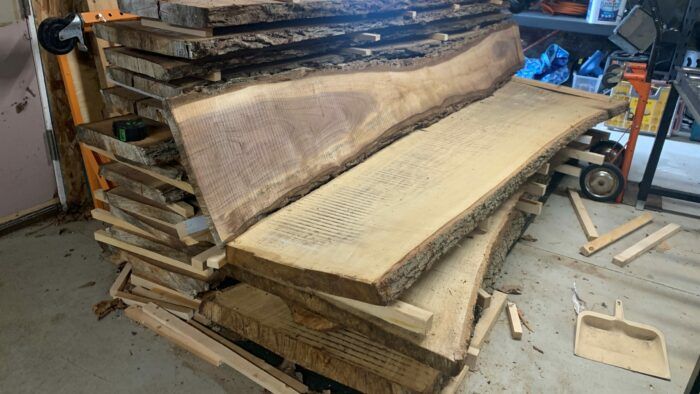Finding and sawing wood slabs
Keep one eye open for found wood, and the other on your wallet.
On the side of the road parked at a gas station in my corner of the Boston area was a flatbed truck, with a large roll of logs peeking out the back. From the light sapwood and the dark center, I knew it was black walnut getting hauled away, most likely headed for the wood chipper.
I turned the car around and asked the driver if those logs were going to any good use. He said no, and he’d be glad to drop some off at my house in the days to come. I had no idea if I’d hear from him again, but the next day he came by and unloaded three of the nicest logs in the stack.
A few weeks later, with the walnut still sitting on my lawn, I crossed paths with another tree guy whose truck was brimming with white oak and maple, some of it more than 36 in. wide. He was glad for me to take it off his hands and save him the disposal fee. The next morning he arrived and one by one emptied the entire haul next to my driveway with a tree grapple. Probably half of it was rotting or fit for firewood, but there was a lot of quality stuff in there that I knew would make decent lumber.
I researched portable sawmills with the vague notion that I could not only create my own lumber, but also help out local folks looking to harvest their own trees.
Before making the investment I decided to contact somebody I know with a WoodMizer to see how much of the pile we could get through in a day, and whether I liked it enough to get my own mill. We started in the morning and by the early afternoon we had cut our way through the three walnut logs and the nicest of the white oak, some of the most beautiful ray-flecked pieces I could have hoped for.
A couple weeks later, I hired another guy with a sawmill to see if we could make it through the rest of the pile. Unfortunately the logs were not stacked with ease of access in mind, and we ended up spending the majority of the time organizing the pile, bucking up the stuff I had no use for, then lifting the logs up onto the mill when we could finally reach them. (Note to self: organize your pile before hiring a sawyer at $200 an hour to do it with you.)
In addition to the white oak, it turned out I had logs of soft and hard maple. With the hard maple I cut five or six boards as well as several slabs, including a 4-in.-thick beauty that was destined to be my first workbench.

Now I’m sitting on a huge stockpile of some of the nicest wood I could ask for. The slabs are stacked up in 3-ft. piles in my basement with a dehumidifier running in hopes that I’ll be able to use them in a couple years.

Last week I cut up three of the slabs in order to make a massive front door for my shop. I brought them to a local guy with a kiln who charges $2 a board foot to dry lumber.
Seeing how much work it was, and how busy I am with work and family, I realize the sawmill business isn’t for me — well maybe when I retire, but for now I prefer to spend my limited woodworking time making furniture and fixing up the shop.
So far it hasn’t been cheap — about $1,500 for the sawmill services.
But I have enough stock to last me a decade at least. It’s local hardwood that would’ve otherwise been thrown away, and that’s worth its weight in walnut.

More like this
 |
The Basics of Milling Lumber |
 |
Video: How to Mill Lumber with Handplanes |
 |
Episode 1: Milling Lumber by Hand |
Fine Woodworking Recommended Products

Grout float

AnchorSeal Log and Lumber End-Grain Sealer

Ridgid R4331 Planer






















Comments
Great blog. I started woodworking in 2015. At this point, much like the author pointed out, if I really wanted to, I could probably find "free" wood for making all of my furniture. As the author also pointed out, free often is really free and one needs to balance time making lumber vs. woodworking. I suppose it's a good problem to have.
Ha! Author writing here.
The good thing is I won't have to do much more of it. I have no idea the actual board footage I have, but i'm sure it will get me through at least a decade of projects - if not a lot more than that.
There's something satisfying about making things with wood that you yourself salvaged and cut. I'm only 40, but i can hear my grandkids now talking about my shop door saying 'grampa cut that wood with his own hands!'
The emerald ash borer decimated hundreds of trees on my farm in Wisconsin. And a century white oak or a maple or beech falls of its own accord in any given year. I don't like seeing saw logs go to waste. So I struck up a friendship with a local fellow with a portable band saw mill. Our first sawing "party" yielded 750 board feet of flat sawn 5/4 ash, which I had kiln dried and milled into random width 3/4 tongue and groove boards that I used to panel a 24 x 24 room in my shop. The second "party" produced 1,500 bf of 8/4 white oak and 6/4 ash, all quarter sawn, which I stickered and air dried. That's a lifetime supply at my age for building tables, chairs, cabinets and jewelry boxes. My sawyer gets all the logs he can use from just one local tree service. Wasting logs by burning or landfilling is unnecessary. Instead, trees should be used for good purpose.
Hey there,
That's incredible! I'd love to see some pics of the shop and some of the stuff you make. Feel free to share them here!
Log in or create an account to post a comment.
Sign up Log in